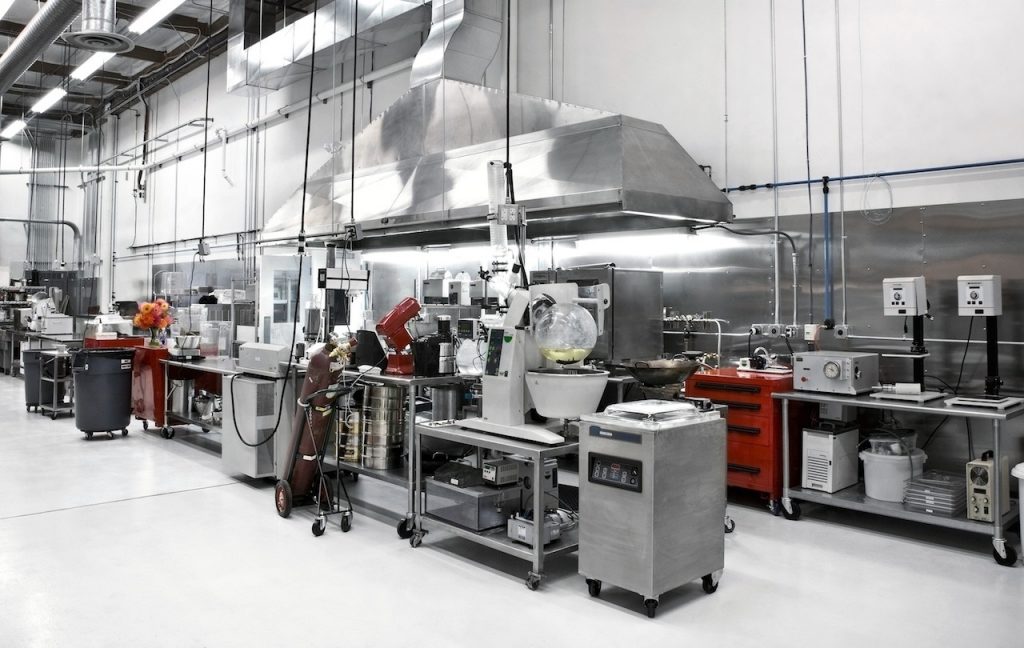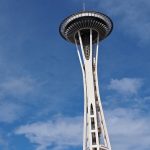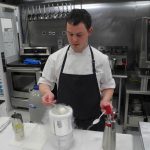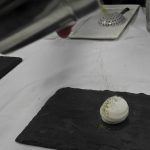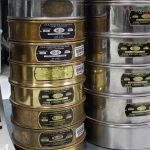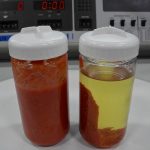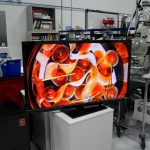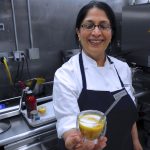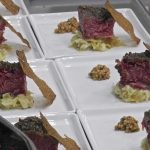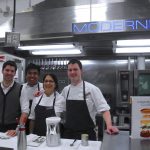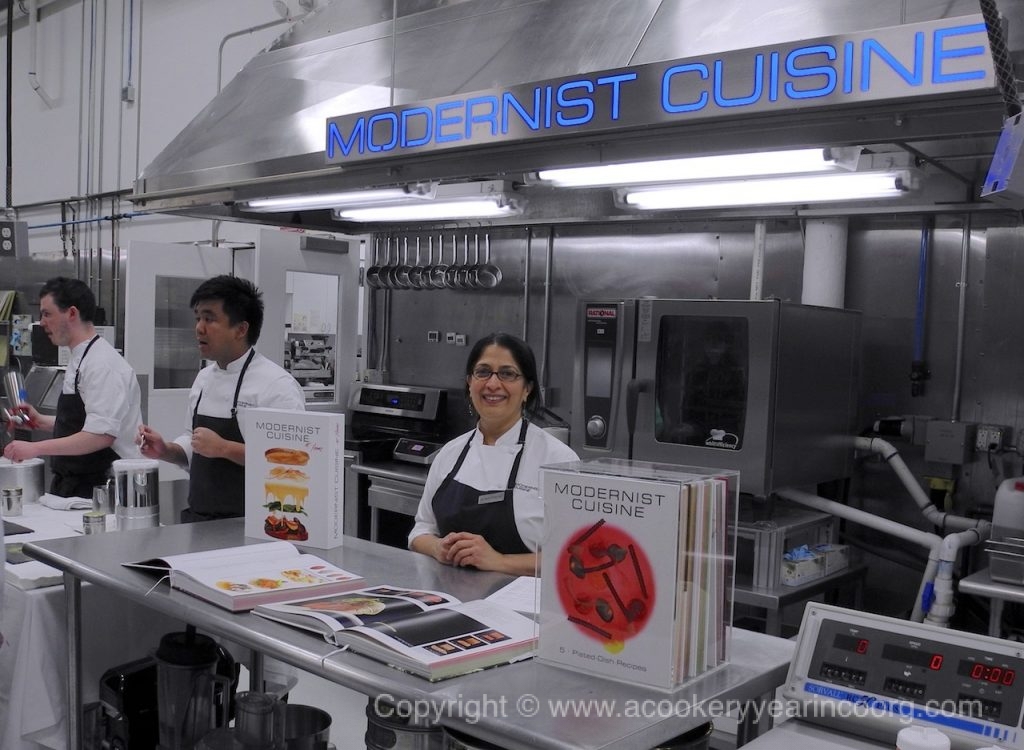Readers of this blog will recall my interview with Chef Anjana Shanker, and her work on the team of Nathan Myhrvold’s “Modernist Cuisine”. Following the release of “Modernist Cuisine”, Myhrvold and his team went on to work on “Modernist Cuisine at Home”, which aims to bring some of the marvels of Modernist Cuisine techniques to the home kitchen. It was released in October 2012 and recently won the IACP award in the “Food and Beverage Reference/Technical” category.
In March this year, we were fortunate to be invited by Anjana to a “Family and Friends” open house event at Intellectual Ventures Lab, the research facility that houses Modernist Cuisine’s “Cooking Lab”.
A Tour of Intellectual Ventures Lab
Driving in to Seattle, it’s hard to miss the Space Needle, the futuristic tower built for the 1962 World’s Fair and the most recognizable symbol of the city ever since. Today, in nearby Bellevue, home to Intellectual Ventures Lab, you might drive right by the discreet building which houses this hub of scientific research without realizing it!
(Picture courtesy Modernist Cuisine)
Intellectual Ventures Lab consists of several scientific laboratories, housed in a large warehouse building. On their website, you’ll learn that these include “dedicated photonics, nanotechnology, biology, culinary and chemistry labs as well as a state-of-the-art machine shop” and also, a “mosquito insectary”.
That’s right, a mosquito insectary! (But more about that later).
Our tour began with a simple demonstration: we were invited to wash our hands at one of the laboratory sinks, rub on a little of a clear gel provided, then watch as a UV light exposed all the bacteria we’d missed! While this little experiment might have been designed to engage the young kids who attended the open house, it served to highlight (pun definitely intended) the fact that this is essentially a scientific research establishment. Laboratory or kitchen, meticulous standards need to be maintained.
Following this, our researchers-turned-guides for the evening showed us a prototype of what must be the world’s fanciest bug zapper! The photonic fence, a device designed to target only the malaria transmitting female mosquito, uses small bursts of energy in the form of an ultraviolet laser to zap them out of the sky. (Watch a video here). It’s only one of the methods being developed and tested in a project initiated at the request of the Bill and Melinda Gates Foundation towards the control and eradication of Malaria. Watching thousands of mosquitoes being carefully monitored in contained glass sided boxes, I was reminded of times in India, when opening the front door at dusk would have been the equivalent of opening the hatch on one of these containers!
We went through some fun practical demonstrations in the Chemistry Department, before moving on to look at a scale model nuclear reactor, a chance to use a geiger counter, and heft a chunk of a heavy metal (there’s a reason why it’s called that!). We stopped by the Photonics Department to listen in on an animated discussion on lasers. Next came Epidemiological Modeling, where there was a colourful display on a large computer monitor, depicting a simulation of the spread of infections by various means through a geographical region – the purpose being to evaluate the effectiveness of policies and strategies aimed at the prevention and eradication of disease.
If all that was a bit of a brain boggler for me, the next stop was reassuringly familiar. In one corner of the building, was a display of some of the amazing photographs and props used in the Modernist Cuisine books. My excitement was building as we were getting closer to the Modernist Cuisine Kitchen, but not before a few more stops and a look at a couple of products designed as part of IV’s “Global Good” initiative, for use in challenging tropical conditions. One was an insulated container designed to store vaccines at optimum temperatures for extended periods, relying only on ice as a coolant. The second, a milk container, rather like a large jerry can, designed to improve dairy hygiene, storage life, and transportation of milk in an African country.
Cool, rainy Seattle and the dust free confines of the IV lab may be pretty far removed from the ground realities of Africa. But we understood from the scientists that they visit the countries concerned, to research field conditions where these products are intended for use.
We had one more stop to make, before doubling back to the Modernist Cuisine display, and that was the Machine Shop, a huge space, filled with advanced machine tools, manual as well as robotic. We learnt that this was where those dramatic cutaways used in the photographs in Modernist Cuisine were crafted.
At the Cooking Lab
Finally! There we were at the Modernist Cuisine Kitchen, which looked strangely familiar from the pictures I’d been looking at in the books and in the media.
Anjana and her colleagues were busy greeting their visitors and showcasing the Modernist Cuisine books as well as answering questions from interested guests. Getting a close up look at the test kitchen was fascinating – from the shelves stacked with an array of neatly labelled spices, such as you might find in a well equipped pantry, to the jars of emulsifiers, gelling agents and coagulants that seem quite at home in a laboratory.
The space is equipped with an array of high tech equipment and precision instruments. Perched atop a centrifuge, was a sample of tomato purée that had been separated by spinning it into its basic components of pulp and a clear juice. (The centrifuge, rotating at speeds of 10,000 rpm or higher, causes suspended particles to stratify by density). We’re told that this liquid retains a concentrated tomato flavour and can be used to dramatic visual effect in Modernist Cuisine dishes like basil tomato spheres.
Somewhere amongst the sous-vide baths, liquid nitrogen cylinders, a rotary evaporator, and laboratory sieves, I spotted a South Indian kitchen staple – a “wet grinder”!
As part of their presentation, the chefs had a few Modernist Cuisine treats lined up for their visitors. Refreshing carbonated green grapes, which fizz like champagne in your mouth, and an amazing nitro poached green apple mousse, sprinkled with green tea dust. Watching Chefs Anjana and Sam Fahey-Burke poaching these meringue like confections in jars of liquid nitrogen was a like scene straight out of Harry Potter, and we were treated to some culinary magic as the light-as-air frozen mousse dissolved in our mouths in a cool breeze of intense green apple flavour!
There was more. We tasted the famous “caramelized carrot soup”, which was a buttery-smooth delight. And finally, the equally famous pastrami, cooked sous-vide for 72 hours, then served with a touch of silky sauerkraut, pressure cooked pickled mustard seeds and stone ground mustard with Cognac, and a tuille-like sliver of pumpernickel bread -meltingly tender meat, accented with subtle textures and layers of flavour, all perfectly plated.
It doesn’t get better than this, being able to sample these preparations while watching the chefs at work in the Modernist Cuisine Kitchen!
I would like to express my sincere thanks to all the friendly folks at the IV Lab for sharing a little of their unique and fascinating world with us.
And thank you, Anjana! Seeing you at work really helped us gain a better understanding of what it takes to produce those results. 🙂
Watch this space for a recipe featuring a technique from Modernist Cuisine that you can try at home.

